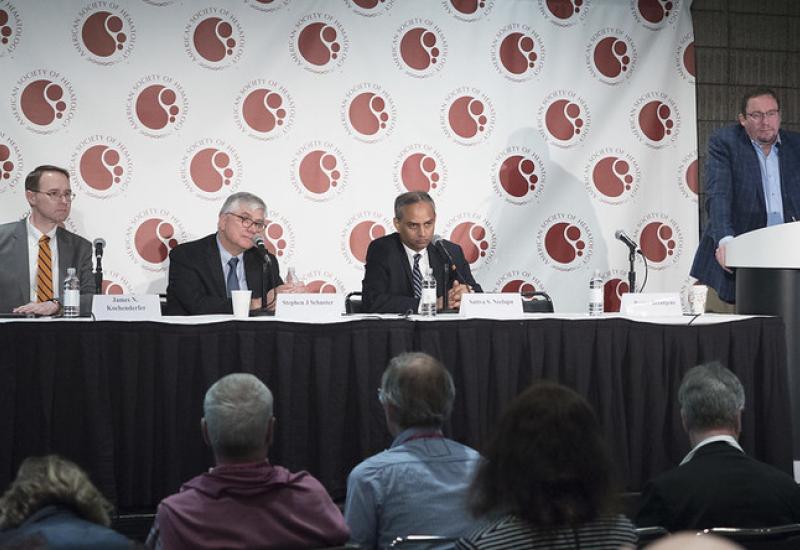
ASCO 2025 preview – KRAS challengers assemble
Lilly, Merck & Co and Verastem could take on Amgen, Bristol and Revolution.
Lilly, Merck & Co and Verastem could take on Amgen, Bristol and Revolution.

The two FDA-approved KRAS G12C inhibitors, Amgen’s Lumakras and Bristol Myers Squibb’s Krazati, have so far failed to live up to sales expectations, and they could soon come under threat from next-generation molecules.
Various KRAS-targeting agents will feature at the upcoming ASCO meeting, with Lilly and Merck & Co’s G12C projects seeing data in colorectal cancer. Meanwhile, a G12D asset from Verastem and GenFleet could take on the current leader here, Revolution.
Colorectal G12C
The focus for KRAS G12C inhibition has so far largely been on KRAS G12C-mutant NSCLC, but there’s also been activity in relapsed colorectal cancer, with a Lumakras/Vectibix combo getting the FDA nod in January, following a Krazati/Erbitux an accelerated thumbs up last year.
ORRs are 26% and 34% with the Lumakras and Krazati regimens respectively.
ASCO will see data from two colorectal KRAS G12C challengers: Lilly’s olomorasib and Merck & Co’s MK-1084.
Olomorasib is being combined with Erbitux, with the phase 1/2 LOXO-RAS-20001 trial showing a 42% ORR, an apparent improvement over the incumbents.
Even more intriguing is a 36% ORR with MK-1084 monotherapy in the phase 1 Kandlelit-001 trial. That study also tested a MK-1084/Erbitux combo (ORR 50%), and a MK-1084/Erbitux/chemo triplet (ORR 14%, although this included front-line patients).
Still, neither olomorasib nor MK-1084 has advanced into specific CRC trials, according to OncologyPipeline. Roche’s divarasib looks like the project to beat in CRC; that company is carrying out the phase 1 Intrinsic trial here.
Verastem’s G12D
KRAS G12D selective inhibition hasn’t yet produced the same wealth of data, but the current leader is Revolution’s zoldonrasib, designed to target GTP-bound (active) forms of KRAS, also known as its “on” state.
Verastem and GenFleet hope to go one better by targeting both the “on” and “off” (GDP-bound) states with their asset, GFH375, and an ASCO abstract suggests that they might be on to something. In a Chinese phase 1/2 trial there was a 43% ORR among seven pancreatic cancer patients – ahead of the 30% previously seen with zoldonrasib in this setting.
However, among nine NSCLC patients, the ORR with GFH375 was 33% – below zoldonrasib’s 61%, although the latter number included unconfirmed responses.
Toxicity could be worth keeping tabs on, with 25% of GFH375-treated patients experiencing grade 3 or 4 treatment-related adverse events. More patients will be needed to gauge the relative merits of the two projects, but G12D is finally getting some data to back up the huge interest in this space.
Separately, ApexOnco has analysed notable ASCO abstracts for ADCs, biologicals more broadly, and menin and KAT6 inhibition. Meanwhile, ASCO’s late-breakers remain secret until their day of presentation, but were covered by ApexOnco when their titles were revealed.
Selected ASCO 2025 regular presentations for small molecules
| Project | Mechanism | Company | Trial | Data | Note |
|---|---|---|---|---|---|
| PF-07248144 | KAT6 inhibitor | Pfizer | Ph1 Faslodex combo in ER+ve breast cancer | ORR 37% w/5mg, 24% w/1mg (total n=43) | 11 Oct 2024 cutoff |
| Olomorasib | KRAS G12C inhibitor | Lilly | Ph1/2 Erbitux combo in KRAS G12Cm, colorectal cohort | ORR 42% (n=93) | 13 Nov 2024 cutoff |
| Olomorasib | KRAS G12C inhibitor | Lilly | Ph1/2 KRAS G12Cm, 1L NSCLC cohort | ORR 70% (n=40) | 13 Nov 2024 cutoff |
| MK-1084 | KRAS G12C inhibitor | Merck & Co | Kandlelit-001, G12Cm colorectal cohort (+/- Erbitux +/- chemo) | ORR 38% (n=101) | 12 Aug & 6 Nov 2024 cutoffs |
| GFH375 (VS-7375) | KRAS G12D inhibitor | Verastem/Genfleet | China ph1/2 in G12Dm solid tumours | ORR 27% (n=22), incl 43% in PDAC (n=7) | 3 Jan 2025 cutoff |
| Ziftomenib | Menin inhibitor | Kura | Komet-001, r/r NPM1m AML | CR/CRh 25% in ph1/2 (n=112), 23% in ph2 (n=92) | 20 Dec 2024 cutoff |
| DZD8586 | LYN/BTK inhibitor | Dizal | 2 studies in CLL after cov or non-cov BTKi & BTK degraders | ORR 50% (n=30), 52% in prior BTKi, 75% in prior BTK deg | 3 Jan 2025 cutoff |
| Zanzalintinib | Multikinase inhibitor | Exelixis | Ph1 Stellar-002, 1L renal cohort | ORR 63% for Opdivo combo (n=40), 33% for Opdivo + relatlimab combo (n=40) | Stellar-001 data didn’t impress in CRC, various ph3 readouts due in 2025 |
| Lenvima | Multikinase inhibitor | Eisai/ Merck & Co | Leap-015, + Keytruda + chemo in 1L HER2-ve GEJ adeno | PFS HR 0.78 (p=0.0019), 0.75 in PD-L1 ≥1% (p=0.0012); OS HR 0.87 (not tested), 0.84 (12.6mth vs 12.9mth, p=0.0244, not stat sig) in PD-L1 ≥1% | Toplined Jan 2025 |
| Tagrisso | EGFR inhibitor | Astra | Ph3 Neoadaura in neoadjuvant NSCLC | EFS HR vs chemo 0.50 for chemo combo (p=0.0382, no stat sig), 0.73 for monoRx | Tolined positive for mPR in Apr 2025 |
| Zipalertinib | EGFR inhibitor | Cullinan/ Taiho | Rezilient-1 in EGFR ex20 ins NSCLC | cORR 40% in post-chemo (n=125), 24% in post-Rybrevant (n=51) | 10 Dec 2024 cutoff |
| Pimicotinib | CSF-1R inhibitor | Merck KGaA | Maneuver in TGCT | ORR 54% vs 3% for placebo | 23 Sep 2024 cutoff |
| Casdatifan | HIF2α inhibitor | Arcus | Arc-20 post-IO renal, Cabometyx combo | ORR 41% (n=22) | 27 Jan 2025 cutoff |
ASCO takes place in Chicago on 30 May to 4 June.
4026













